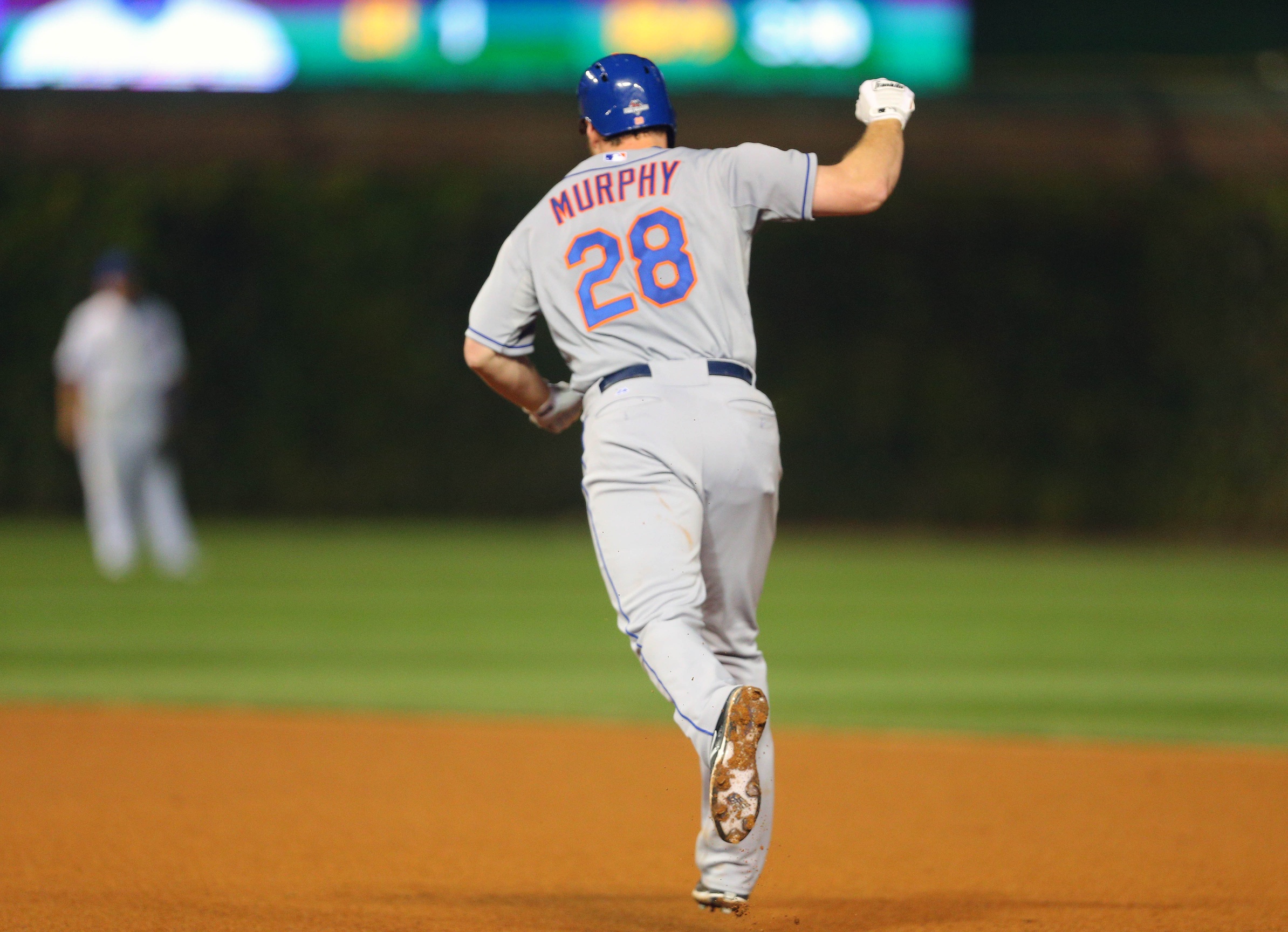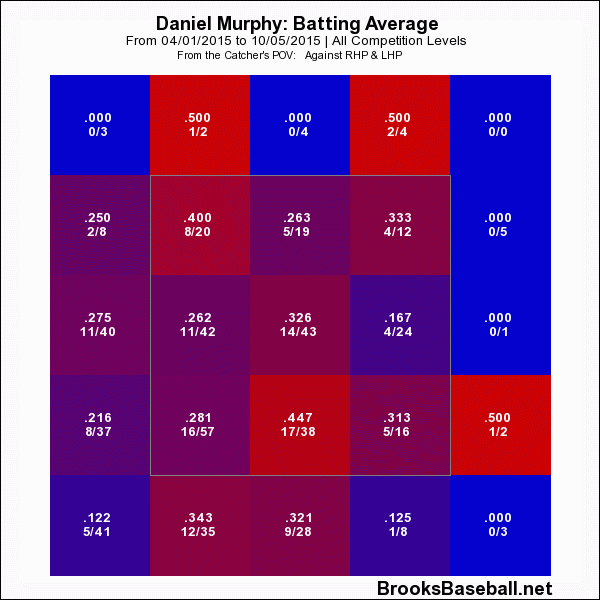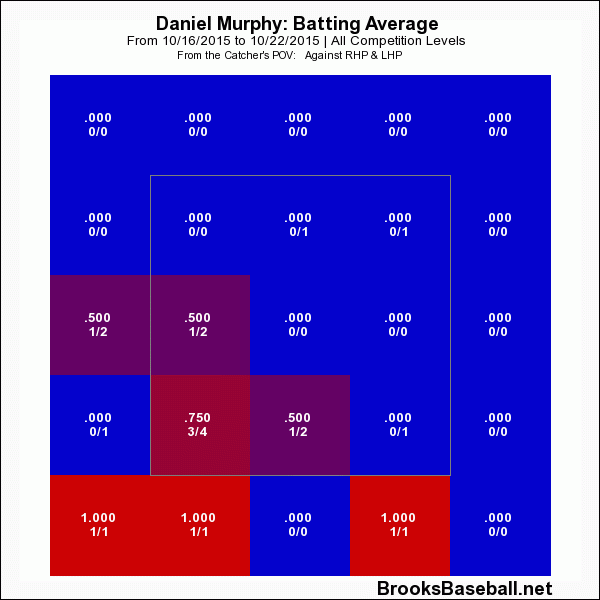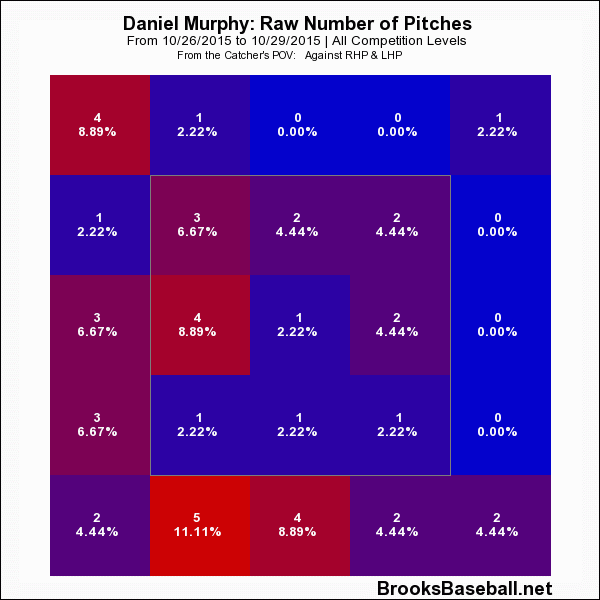Daniel Murphy has been one of the biggest stories of the postseason, and all he had to do is beat the odds and crank out seven home runs in his first nine playoff games. That sounds like some stat that you might hear about the likes of Barry Bonds, Alex Rodriguez, or David Ortiz. Daniel Murphy? Give me a break. These are the types of things that cause most of us to shrug and sigh, “Baseball is weird.”
Four of those dingers came in the Mets four-game NLCS sweep of the Cubs, who simply couldn’t figure out how to get Murphy out, much less keep him in the ballpark. Was there anything the Cubs could’ve done differently, in hindsight? Some have argued that Murphy looked “too comfortable” at the plate, and that the Cubs should’ve drilled him with a pitch intentionally. Plunkin’ Daniel Murphy? The only issue with this theory is the complete lack of evidence to support it.
Murphy has recorded just 11 plate appearances in the big leagues in which he’s been hit by pitch (HBP), but I thought it was worth taking a look into whether there was a noticeable trend in his past that could lend credence to the “HBP theory.” Truthfully, there is not:
When you see a batting average difference of only 0.03 and an OPS difference of just 0.024, both in a sample size of 10, it’s fair to chalk up the differences between the two sets of data to random error. And if you expand the sample size? My conclusion, based on a total sample of 220 plate appearances, is that being hit by a pitch has had no real measurable effect on Murphy’s performance.
I asked BP’s Rob McQuown to help me get even closer to understanding the big picture, as I thought just Murphy’s numbers regarding a HBP might not truly show whether there is merit to the idea of plunking a guy to cool him down at the plate. He gave me 2015 stats on all players in Major League Baseball as well as the stats on the first 10 plate appearances following all plate appearances that resulted in a HBP.
Weighted: .258/.327/.417
Unweighted: .255/.318/.412
10 PA post HBP: .256/.323/.410
The weighted stats are season stats weighted by the number of PA for each player measured in the post-HBP plate appearances (e.g. Albert Pujols’ 2015 stats are weighted 60 times for the six HBP he had). Unweighted is simply the raw MLB stat line from 2015.
Following the same rationale we used on Murphy’s stats, we can draw the same conclusion—the numbers are intensely close, so much so that even the most fervent debater could not reasonably conclude that throwing at a guy is a good way to get him to stop hitting home runs. The numbers just do not support this theory.
Considering that Anthony Rizzo was plunked 30 times just this season, it’s kind of amazing that Murphy has avoided the bean-ball so well. This means one thing, at the very least: if it really is a prominent thought around baseball that guys on a hot streak need to be drilled to be made less comfortable, Murphy must not go on a lot of prolonged hot streaks.
If hot streaks are measured by home runs, that would be correct. Murphy has only two multi-homer games in his career, first performed against (who else?) the Cubs in 2012. He only has one time in his career where he’s hit homers in back-to-back games, which he did on May 1st and 2nd of 2009. Game One of the World Series broke his streak of six consecutive games of hitting a home run this postseason.
So maybe this is more related to the Cubs than it is to Murphy. After all, they’re the ones that allowed him to go 9-for-17 in the NLCS. For some reason, despite being just an average hitter over the course of his career, Murphy really loves hitting against Cubs pitching. Including playoff stats, he’s hit balls out of the park at a far higher rate off of them than against the rest of the league.
The playoff numbers obviously skew it just a little, but he still clearly enjoys stepping into the batter’s box against the Cubs, especially at Wrigley Field. And how many times have Cubs pitchers drilled him with a pitch to send a message of some sort, or make him less comfortable at the plate? Zero. These are professional hitters, and if their minds were easily manipulated by a simple HBP you’d see a lot more intentional beanings.
The Cubs lost for a variety of reasons, not just because of Murphy’s sudden homer-happy streak. One such reason was that the Cubs were simply outplayed by the Mets in every facet of the game. But the Cubs also had a fair amount of bad luck, too. Look at some of the key team hitting numbers from the series.
The strikeouts are exactly the same and the walks are nearly the same, indicating that the level of play of both teams was a lot closer than the final scores may have indicated. But look at the team BABIP. The eye test would tell you that while the Cubs couldn’t buy a hit, the Mets were jumping all over Cubs pitching. The stark difference in batting average on balls in play tells a lot of the story.
Balls in play are not merely reflective of a hitter being good or a pitcher being bad in that specific moment, but of many other variables such as hit placement, sequencing, and fielding. Much too often, the non-pitching and non-hitting variables seemed to fall in the Mets favor.
Which brings us back around to Murphy. The average exit velocity on his home runs was right at 100 mph, which includes a two-run homer off Jake Arrieta. Talk about luck—just look at where this pitch is located, the exit velocity via Statcast, and the distance where it lands.
The pitch is nearly six inches below the bottom of the strike zone, in a nearly impossible-to-hit location. The ball only leaves Murphy’s bat at 90.7 mph, which qualifies it as one of the softest hit home runs of the 2015 season. Finally, it barely gets out in the shortest part of the park, traveling just 350 feet down the right-field line. There’s not much you can really do about this but shrug your shoulders. Murphy’s Law, I guess.
In two games against the Royals in the World Series, Murphy is just 2-for-9 (both singles). It’s possible the Royals know something that the Cubs didn’t about how to get Murphy out, or maybe they’ve merely executed their pitches better. Or it could just be that baseball is weird. Here is Murphy’s batting average by hitting zone from the regular season, so you can get an idea of where he liked the ball.
He hits well against pitches that are in the middle of the zone and down, as well as low of the zone in the middle and away. In comparison, here is where he collected his hits against the Cubs in the NLCS:
A lot of his hits came in some of his weaker hitting zones, with only two of his hits coming in areas where he hit over .300 in 2015. So it’s not as if the Cubs just put cookies out there in his happy spots. Now compare that to where the Royals have thrown the bulk of their pitches to Murphy:
The Royals have thrown 33 percent of their pitches to Murphy in his five favorite hitting zones. On paper, it doesn’t seem like the best strategy for getting him out—but it’s working so far.
The thing that stands out the most is the type of pitches the Royals have used in the first two games against Murphy. While the Cubs threw him 25 sinkers, 18 fastballs, and just five changeups in their four games, the Royals have thrown him 18 fastballs, 11 change-ups, and just five sinkers in their two games. After seeing that, you probably won’t be surprised to find that he absolutely crushed sinkers this season, to the tune of a .371 average and .573 slugging percentage. At the same time, he struggled with the changeup.
Anyone who thinks that putting one into the ribs of Murphy might have changed anything in this series is simply wrong. Even if the Cubs had done it all the way back in Game One, there’s no evidence that would support the series playing out as anything but a sweep in the Mets favor. There were too many factors that worked against the Cubs in the NLCS, and hitting a batter would’ve done nothing to change that. The best strategy was for the Cubs to continue to try to get him out.
Unfortunately, “trying to get him out” didn’t work against Murphy—or against many of the Mets hitters, for that matter. It’s worked for the Royals, who haven’t had to consider resorting to hitting him with a pitch (yet, anyway). The Cubs consistently threw Murphy sinkers, which accounted for four of his nine hits and two of his four homers. In short, they tempted him with pitches that he likes in zones where they thought he might make more outs.
But again, just one player didn’t make the difference in the Cubs winning or losing that series. The series was a lot more even than it looked to the naked eye; for example, the Cubs struck out 37 Mets hitters in 34 innings and kept the walks to a relative minimum, with just 11 total. On the flip side, the Mets struck out 37 Cubs hitters and walked just nine in total. The end result: the Mets outscoring the Cubs 21-8 and a series sweep.
Baseball is weird.
Lead photo courtesy of Dennis Wierzbicki-USA TODAY Sports








If you put one in his ribs, he is standing at 1st instead of crossing the plate. Id rather just hit him.
More runners on base is generally a bad way to avoid giving up runs.